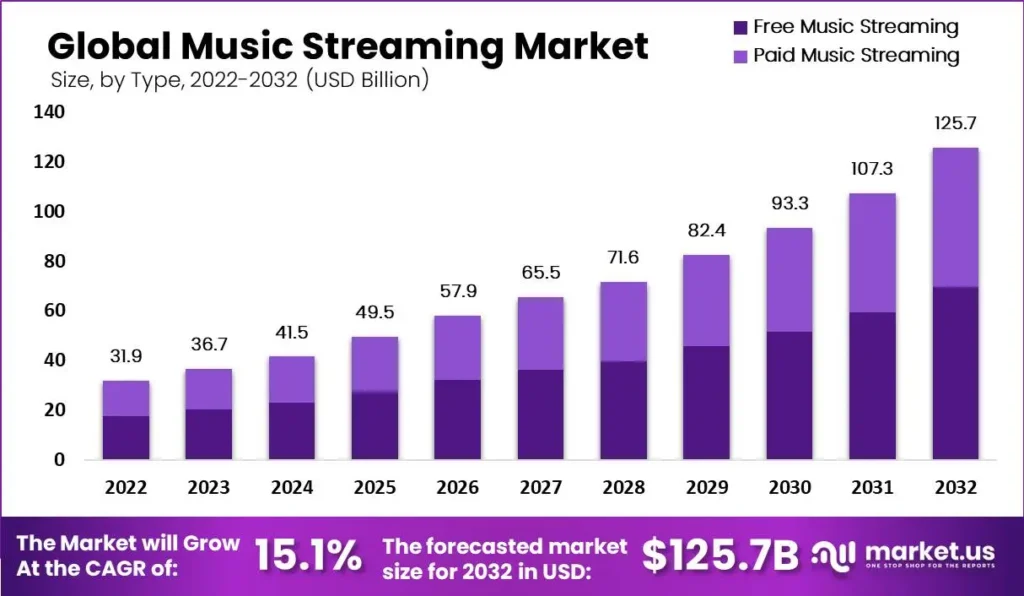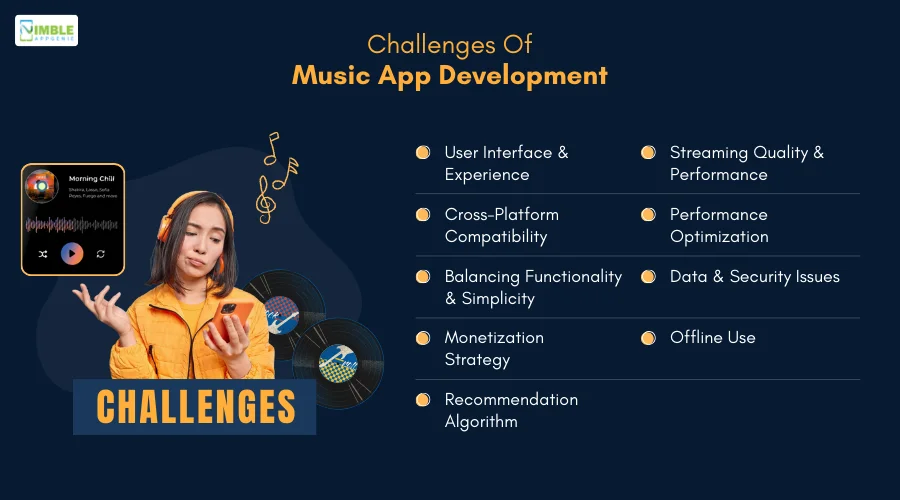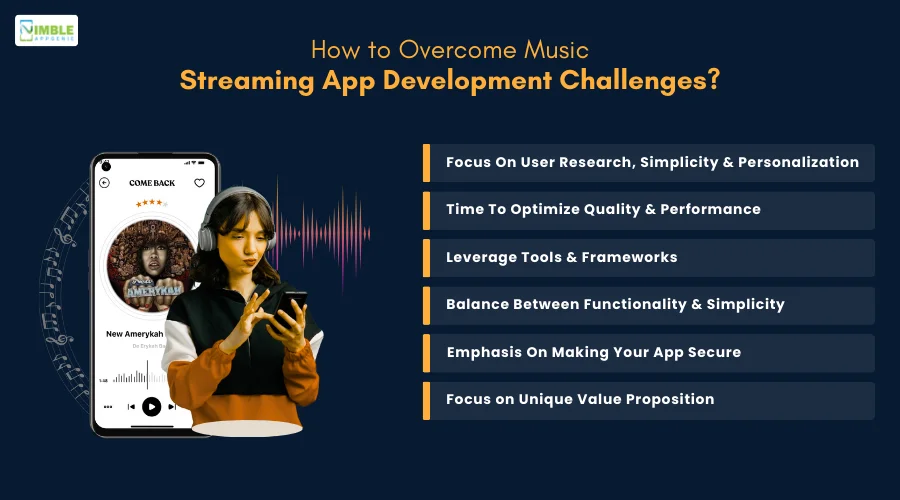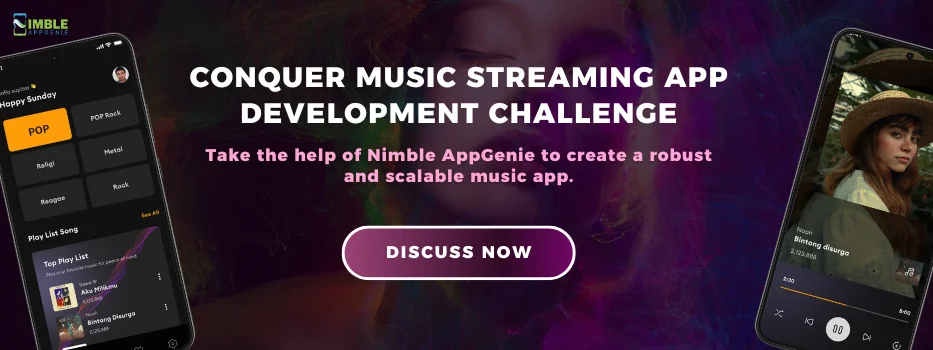The majority of music lovers, over 80%, have embraced streaming services.
This clearly shows that the popularity of music apps is on the rise. And there is no going back from here.
Now, with that said, many investors are planning to enter the market with a top music app, but several underlying challenges are waiting in the path that need to be addressed.
In order to be a user favorite and make a name in the market, you should get to know about these challenges and overcome them.
So, if you are ready to create your own music app? We then explore the key challenges and provide actionable solutions to help you navigate them with ease.
So, without any delay, let’s get in:
Global Music Streaming Market Statistics
The Music App Market is flourishing!
To back this up, here are some amazing statistics about the music app market.
The music industry is booming, with music streaming services expected to rake in a whopping $125.7 billion by 2032! This incredible growth, at a rate of 15.10% per year, is fueled by the massive popularity of free, ad-supported streaming.

Easy access on mobile devices and the convenience of on-demand listening, where users can personalize their experience, are driving this trend.
User-friendly music streaming apps are king, allowing melomaniacs (music lovers) to carry their entire libraries with them wherever they go.
Challenges of Music App Development
Music app development can be an exciting venture but also filled with many hurdles.
Let’s discuss some of the common challenges you’ll likely face:

► User Interface & Experience
When it comes to user interface & experience, they can make a great impact on your app’s success.
But, for that, you need to ensure that the UI/UX design of your app is user-friendly, if it’s not, then it will not take much time for users to abandon your app and run to your competitors. That, you surely don’t want to happen.
Also, their needs are constantly changing and so is their interaction with apps. It has become a huge mobile app development challenge to cater to their evolving demands.
► Streaming Quality & Performance
There are various successful apps like SoundCloud present in the market, and one fundamental element that made them so successful is the high-quality streaming experience that they provide to their users.
Maintaining first-class audio streaming while minimizing buffering and latency is necessary for a smooth user experience.
Developers need to find a viable solution to ensure that your app works without lagging or compromising quality, meaning you need to ensure reliable performance across different network conditions.
► Cross-Platform Compatibility
Music is something that keeps us going throughout the whole day.
If you are developing an app like Audiomack that can work seamlessly across various devices and operating systems, i.e. Android & iOS, then it’s a complex element that needs your attention.
Developers often need to find cross-platform development frameworks or adopt a hybrid approach to ensure that music apps can ensure consistency and compatibility. This is surely one of the top music app development challenges that you shouldn’t overlook.
► Performance Optimization
To ensure that your music discovery app is launched successfully in the market. It becomes necessary that your app loads quickly and functions smoothly on devices with limited resources.
Earlier in this segment, we talked about how it is important that your app works on different devices, but by adding more to it, you should also ensure that your app performs well.
To do so, it becomes important that your music streaming app works well across different devices and network conditions. Plus, streaming music consumes a lot of battery and data, but can be optimized with background playback features that minimize battery drain.
It is really important to address such challenges while adding crucial features; only then can developers create a music streaming app that delivers a seamless and enjoyable user experience.
► Balancing Functionality & Simplicity
Yes, adding too many features can clutter the interface and overwhelm users.
Striking a balance between offering enough functionality and maintaining a clean design is a challenge. This is why it becomes very important to provide users with the necessary features that don’t create cluttered and confusing interfaces.
If a user gets overwhelmed due to clutter, they might run away from your app.
► Data and Security Issues
In these times when cyber-attacks are so common, data and security measures have become music streaming trends that you don’t want to miss.
Music streaming apps collect a lot of user data, including listening habits, location information, and even search queries. So, making sure that all this information of a user is safe is necessary for your brand’s identity and to gather user trust.
Only then, you can make a successful app and win over your users.
► Monetization Strategy
The music streaming landscape is dominated by apps like Spotify and Apple Music.
A new music app needs to find a way to stand out and convince users to switch or pay for their service. It becomes important to focus on a niche audience or offer unique features like high-fidelity audio, exclusive content, or social integration to differentiate the app.
To make your music app increase its value proposition and likelihood of converting to paid subscriptions, you need a highly engaging app experience.
By carefully considering these challenges and implementing a monetization strategy, music app developers can build better business models and create an app like Spotify that exceeds expectations.
► Offline Use
Whether someone wants to cut down their expenses or wants to just enjoy good music in their flight journey, enabling users to download music for offline playback requires efficient storage management.
Large music files can quickly consume a device’s storage capacity, especially on budget smartphones. The app needs to be optimized for user storage efficiently and allow users to control which songs they want to download.
This way, you can win them over and also make your app open to every type of person.
► Recommendation Algorithm
Music Streaming Apps rely heavily on recommendation algorithms to keep users hooked.
These clever algorithms analyze your listening habits and preferences to suggest new music you might love, albums, playlists, and even artists.
Think of them as your personal music matchmakers!
By suggesting new, relevant, and enjoyable music, they discover music that resonates with your tastes, so you keep coming back for more. No more wading through endless music libraries. Recommendations help you find music you’ll truly enjoy.
With that, as you get to know about these challenges, it’s time to also look at some of the ways to overcome such hurdles.
How to Overcome Challenges in Developing Music Streaming Apps?
As we covered some challenges, there are several exciting opportunities you should explore to overcome these hurdles.
Without any further ado, let’s get to know them in the section below:

♦ Focus on User Research, Simplicity And Personalization
To create an app like Deezer, you must spend time on thorough market app research and their needs.
You should conduct user testing throughout the development process to identify and fix usability issues.
Keep the interface clean and intuitive, with easy-to-understand navigation. Offer features like custom playlists, recommendations based on their listening habits, and the ability to customize the interface layout.
♦ Time To Optimize Quality & Performance
Implement adaptive bitrate streaming, which adjusts audio quality based on available bandwidth. Also, developers need to use well-written, efficient code to minimize resource usage and improve app performance.
Allow users to download any kind of music they like for offline listening to reduce reliance on data usage. Other than that, implement caching of frequently accessed data to improve loading times.
This way you can combat the big challenge of developing a music app and help your users enjoy a good experience if you want to launch a successful app like Shazam.
♦ Leverage Tools and Frameworks
You want to make sure that your music app works well on different devices and platforms.
Well, the best way to achieve this is to work on tools like React Native, or Flutter which allows you to build an app once and deploy it on multiple platforms Android & iOS with minimal code changes.
Also, test the app on various devices and operating systems to ensure a consistent and smooth user experience. There are several tools and frameworks that can work for you to develop an app that works well on any device.
♦ Balance Between Functionality & Simplicity
Offer a basic set of features for everyone and provide advanced functionalities through premium subscriptions or in-app purchases.
You can reveal advanced features through menus or options that users can discover as needed, keeping the basic interface clean. Also, you should allow users to customize the interface and choose which features they want to see.
♦ Emphasis On Making Your App Secure
Implement strong encryption practices to protect user data in transit and at rest.
Communicate what data is collected, how it’s used, and obtain explicit user consent. Also, conduct regular security audits to identify vulnerabilities and update the app with security patches promptly.
Also, ensure the app complies with relevant data privacy regulations like GDPR and CCPA.
♦ Focus on Unique Value Proposition
If you want to open up various revenue models for your app, then you must work on a unique value proposition that offers subscription tiers with varying features and price points to cater to different needs and budgets.
Other than that, you can offer additional features like ad-free- listening or song downloads as in-app purchases alongside subscriptions.
These are some of the ways one can make sure to develop a user-friendly app. Make sure to follow these tips.
Nimble AppGenie, Your Music Streaming App Partner
Are you looking to launch a feature-rich music streaming app? So, you should partner with a top music app development company.
We can help you overcome any challenge in development and assist you in launching a robust and scalable music app. Our team of expert developers, designers, and professionals is always ready to serve the client with the best.
If you want to discuss your project or know about the cost to make a music streaming app, then contact us for further details.
Conclusion
The music streaming market is booming, but building a successful music app requires overcoming several challenges.
By focusing on user experience, performance optimization, and a secure platform, you can create an app that stands out.
Remember, a well-crafted monetization strategy is crucial to ensuring long-term success.
With careful planning and execution, you can overcome these hurdles and create a platform that delights users and thrives in a competitive market.
FAQs
Balancing functionality and simplicity, ensuring high-quality streaming performance, and developing a secure platform for user data are some of the biggest hurdles.
Offer a unique value proposition by focusing on a niche audience or providing exclusive features. User-centric design and a focus on personalization can also help you differentiate your app.
A tiered subscription model with different feature sets and price points is a common approach. You can also offer in-app purchases for ad-free listening or song downloads.
Extremely important! User data needs to be protected with strong encryption practices. Transparency about data collection and compliance with data privacy regulations are also crucial.
Cross-platform tools like React Native or Flutter allow you to build an app once and deploy it on both Android and iOS, saving time and resources.

Niketan Sharma is the CTO of Nimble AppGenie, a prominent website and mobile app development company in the USA that is delivering excellence with a commitment to boosting business growth & maximizing customer satisfaction. He is a highly motivated individual who helps SMEs and startups grow in this dynamic market with the latest technology and innovation.
Table of Contents






No Comments
Comments are closed.